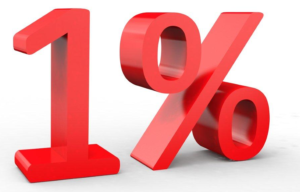
13 Jun How You Can Evaluate Potential Deals Quickly With the 1 Percent Rule (and the 2 Percent Rule)
To find solid rental properties to buy, you need to sift through a lot of potential deals. A must for a landlord is to have positive monthly cash flow once the property is stabilized. By stabilized, I mean that you have removed any bad tenants, conducted necessary repairs, and then rented the place. For these examples, I assume that you have a mortgage loan or will have a loan through a cash-out refinance. Therefore, the rent must cover the operating expenses of the property plus the monthly debt service.
To whittle a large pool of possible properties down to a short list, you need an analytical shortcut. For that quick analytical formula, I present to you the 1 Percent Rule.
The 1 Percent Rule
The 1 Percent Rule states that the actual or projected monthly rent must be at least 1 percent of the purchase price plus any upfront repairs.
So, you’re looking through houses on the market. The first one up is a pristine home listed for sale at $165,000. You believe that the average monthly rent is $1,000. You decide to pass on this one. Why? The $1,000 per month is less than one percent ($1,650) of the asking price of $165,000. The $1,000 probably won’t produce much, if any, positive cash flow for you.
Next you see a move-in ready house in a desirable neighborhood with an asking price of $150,000. You believe the average monthly rent is $1,500. Since the house won’t need any upfront repairs and since the monthly rent of $1,500 is one percent of $150,000, you smell a deal and decide to analyze the property further.
You evaluate a third property. It is a fixer-upper with an asking price of $90,000 and you believe it will require around $30,000 in renovations. The average monthly rent is $1,400. Since the total acquisition cost is $120,000, you likewise smell a deal since the $1,400 rent is more than one percent of $120,000.
In another situation, you come across a seller who asks for $150,000 for their move-in ready single family house. If the rent you could collect is far less than $1,500 a month, either you pass on the opportunity or you recognize that you would have to negotiate a price below $150,000.
Take it a slightly different way. You come across a landlord who wants to sell their rental house, and it is not on the market. The landlord does not have an asking price yet. The current rent is $2,000 a month. You know in your head that $200,000 could be a lucrative offer price. Of course, there are other factors and other analysis you must conduct. We’ll describe those factors and analytical needs in a moment.
A Real Life Example
My wife and I scour the market daily. We look at listings with Realtors®, auction websites, Zillow.com, For Sale By Owner houses, and we talk to landlords who wish to sell. The most recent deal we purchased had just been listed for $125,000 that morning. It was a move-in ready townhouse located in a desirable neighborhood only 12 minutes from our home. By noon, we were looking at the property. By 1:00 p.m., there were two other offers on the house. We made an offer for $122,000 by 3:00 p.m. that day. We stated that we would not conduct inspections, and we said that we would close in 17 days. Even though the seller received offers higher than our $122,000 price, the seller liked our terms and accepted our offer. We closed on the house in 17 days, as promised. The night before we held the settlement, we signed a lease for $1,230 per month with a new tenant.
One percent of $122,000 is $1,220. We knew we had a solid deal with the $1,230 per month in rent. Factoring in operating costs and debt service, our monthly cash flow is $405. I consider that a great little deal.
Therefore, if the rent is at least one percent of the purchase price plus upfront repairs, you have a green light to conduct further analysis and perhaps make your offer.
Other Factors
Of course, there are other factors to consider. First, the 1 Percent Rule assumes that you will purchase the house in a desirable neighborhood. It would be a working-class area with affordable housing and a good mix of homeowners and renters. You would feel safe walking around this type of neighborhood at any time of the day. Houses in the neighborhood would appreciate in value by three percent or more per year, on average.
You need to consider the property’s location, condition, and potential expenses. As mentioned, the 1 Percent Rule is not just based upon the asking price. You must factor in upfront repair costs. If you will pay for the tenant’s water or heat, costs like those will eat into your cash flow. If the house is located in a flood plain, the cost of flood insurance will lower your cash flow. If the house is advertised as a three bedroom home with two bathrooms, but two of the bedrooms are tiny walk-through bedrooms and one of the bathrooms is a filthy toilet in the basement, you might not command the same rent as a normal three bedroom, two bathroom home would.
Another factor is your evaluation of the monthly rent. What if rents go down due to a recession? What if the house has never been rented before and you are not really sure what the market rent would be? My wife and I look at the Zillow Rent Zestimate and use RentOMeter.com to quickly evaluate the potential rent. You can also call property managers, Realtors®, or landlords in the area to pick their brain on market rents.
The 2 Percent Rule
The 1 Percent Rule might not work as well in more blighted or depressed neighborhoods. Neighborhoods like those may have higher crime rates, fewer job opportunities, high tenant turnover, and housing prices that do not go up (and may even go down). You might not feel safe walking around at night. For neighborhoods like those, many landlords rely upon the 2 Percent Rule. They do so because they are seeking high cash flow in exchange for the investment risk.
For instance, a house is selling for $60,000 in a blighted neighborhood and you believe the market rent is $900 a month. You might pass on this opportunity (even though it meets the 1 Percent Rule) because you want a monthly rent of at least $1,200.
Let’s say you come across another house in the same area. The asking price is $75,000, and it is currently rented for $1,500 a month. $1,500 is two percent of $75,000. You smell a deal and choose to evaluate the property further. If you have a stable tenant and a house that doesn’t need too much work, you know that the cash flow will be amazing. You might not care if the value of the home does not go up over time. Some people might even hire a property manager so they can sit back and let the money come in while someone else oversees the property.
The 1 Percent and 2 Percent Rules are merely guidelines to tell you to more closely analyze certain potential deals over others. You should not make a purchase decision merely because the actual or potential rent is at least one percent or two percent of the asking price. Every property is different, and it is imperative that you take a deep data dive into the numbers. Each property’s numbers tell a story. The 1 Percent and 2 Percent Rules are there to help you whittle 100 available properties down to 10.
Tai DeSa is a graduate of The Wharton School of the University of Pennsylvania. He became a full-time real estate investor in 2004 after serving in the U.S. Navy. Tai has made colossal mistakes in investing (and learned some things along the way). He has helped hundreds of homeowners avoid foreclosure through successful short sales. Check out Tai’s books on Amazon.com. Tai may be available for coaching and speaking engagements on a variety of real estate topics. Send an email to tai@investandtransform.com.






No Comments